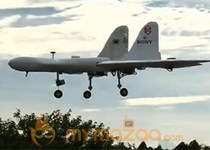Remember the airplane-shaped drone Sony announced last month? The company's just taken it for a test flight and posted the results on YouTube.
First impressions are pretty good, with the flying machine shown performing a vertical take-off before tearing across the sky at speed and returning for a smooth landing. The drone incorporates a rotor in the center of the craft, while the video also shows movable flaps as part of the wing design to aid control.
But if your fingers are already twitching in anticipation of a fun weekend fiddling with the drone's controller, then hold up -- this one's for business, not consumers. The plan is to offer it to industries looking for an efficient and reliable way to carry out tasks such as measuring, surveying, observing, and inspecting land or equipment.
Collaboration
The plane-like copter is the result of a collaboration between the Japanese tech giant and ZMP, a Tokyo-based firm that develops autopilot technology.
The new enterprise, called Aerosense Inc., combines Sony's camera, sensing, telecommunications network, and robotics technologies with ZMP's automated driving and robotics technologies, as well as its business experience in the relevant industries.
According to its website, the new drone weighs 15.5 pounds and has a maximum load capacity of 22 pounds. It can reach speeds of just over 100 mph and fly for up to two hours on a single charge.
The flying machine, which has a wingspan of 7.2 feet, is designed to carry out tasks autonomously, relaying gathered data to operators back at base via its on-board camera.
Aerosense wants to start selling its creation to interested businesses from early next year, though their use will of course depend on local regulations for commercial drone flights.
Playing catch-up
Aviation bodies in most countries are still playing catch-up when it comes to setting guidelines for commercial drone flights, with the Federal Aviation Administration, for one, still working on new rules for such flights in the U.S.
The FAA's seemingly slow response to the fast-developing technology has frustrated a number of U.S. companies, including Amazon, which is keen to use autonomous drones to deliver goods to customers.
Even NASA has been getting involved, working with a slew of companies to develop an air traffic control system that could one day monitor and manage potentially thousands of commercial drones flying above our cities at any one time.







